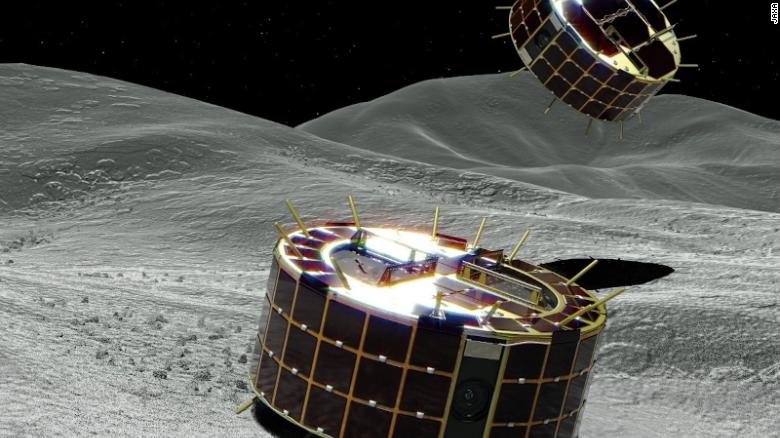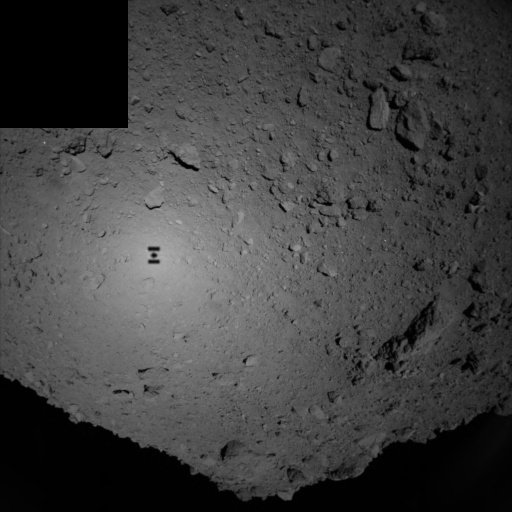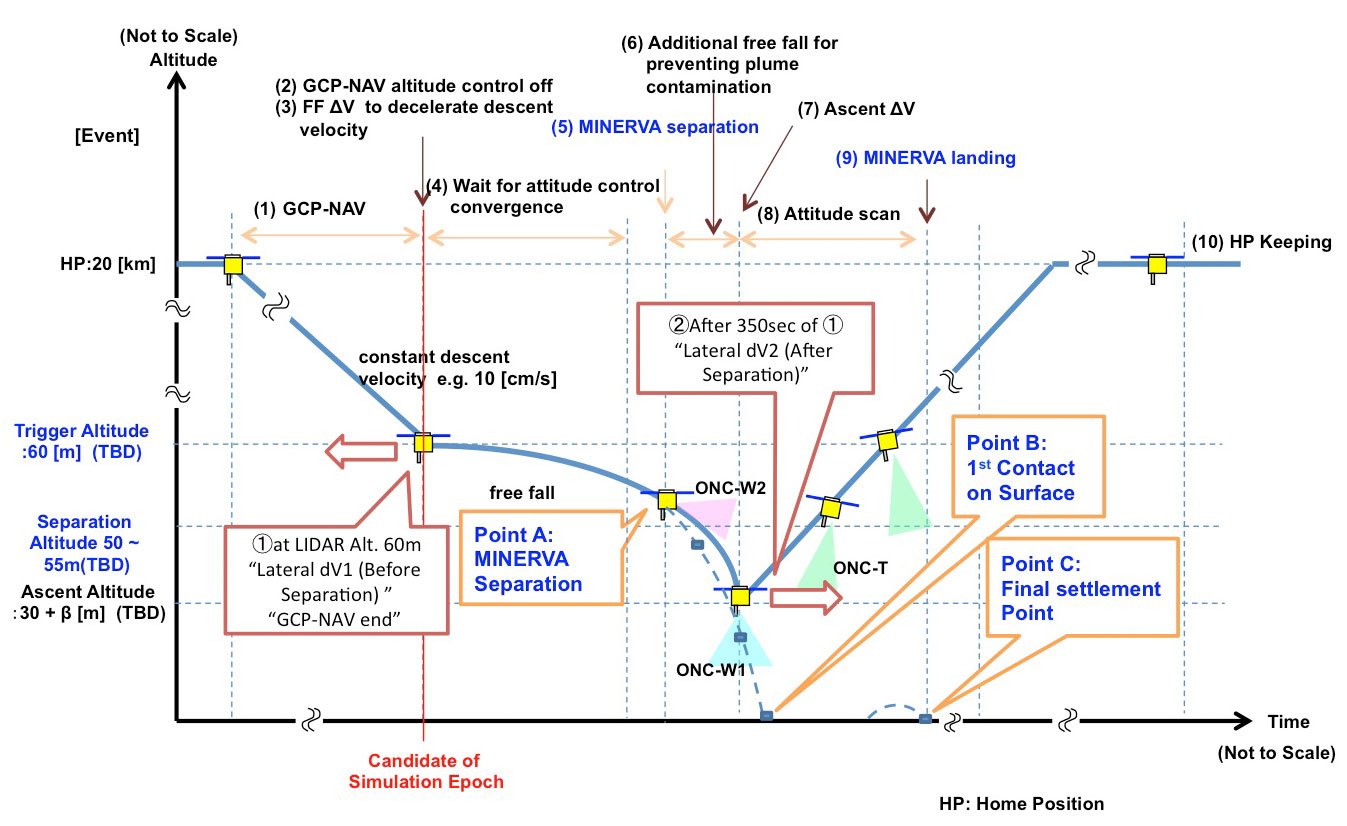- begin quote from:
Japan's Hayabusa-2 probe touching down on distant asteroid
 Illustration of Rover-1A (back) and Rover-1B (foreground) from MINERVA-II1 as they explore the surface of Ryugu.(CNN)Japan is in the process of landing two unmanned rovers on a distant asteroid, according to tweets from the country's space agency, nearing completion of a task which it has previously described as the equivalent of hitting a 6-centimeter (2.4-inch) target at 20,000 kilometers (12,400 miles) away.The Japan Aerospace Exploration Agency (JAXA) announced at 1 p.m. local time Friday (12 a.m. ET) that two vehicles, Rover-1A and 1B, collectively known as MINERVA-II1, had successfully been deployed from the Hayabusa-2 spacecraft.If everything goes according to plan, the landing craft should touch down on the surface of the asteroid, which is named Ryugu, by 4.30 p.m. JST (3.30 a.m. ET).As the craft approached to within 100 meters (328 feet) of the space rock, it sent back a photo showing Hayabusa's shadow projected onto its barren, cratered surface.As it neared touchdown, JAXA tweeted that the control room was silent save for the sound of "deep breaths."The 1km-wide space rock, which is shaped like a diamond, is expected to be "rich in water and organic materials," allowing scientists to "clarify interactions between the building blocks of Earth and the evolution of its oceans and life, thereby developing solar system science," JAXA said.
Illustration of Rover-1A (back) and Rover-1B (foreground) from MINERVA-II1 as they explore the surface of Ryugu.(CNN)Japan is in the process of landing two unmanned rovers on a distant asteroid, according to tweets from the country's space agency, nearing completion of a task which it has previously described as the equivalent of hitting a 6-centimeter (2.4-inch) target at 20,000 kilometers (12,400 miles) away.The Japan Aerospace Exploration Agency (JAXA) announced at 1 p.m. local time Friday (12 a.m. ET) that two vehicles, Rover-1A and 1B, collectively known as MINERVA-II1, had successfully been deployed from the Hayabusa-2 spacecraft.If everything goes according to plan, the landing craft should touch down on the surface of the asteroid, which is named Ryugu, by 4.30 p.m. JST (3.30 a.m. ET).As the craft approached to within 100 meters (328 feet) of the space rock, it sent back a photo showing Hayabusa's shadow projected onto its barren, cratered surface.As it neared touchdown, JAXA tweeted that the control room was silent save for the sound of "deep breaths."The 1km-wide space rock, which is shaped like a diamond, is expected to be "rich in water and organic materials," allowing scientists to "clarify interactions between the building blocks of Earth and the evolution of its oceans and life, thereby developing solar system science," JAXA said. [MINERVA-II1] Hayabusa2 has started its descent and the images taken by the Optical Navigation Camera Wide angle (ONC-W1) for navigation are being released in real time at this gallery link: http://www.hayabusa2.jaxa.jp/en/galleries/onc/nav20180920/ … [Image credit: JAXA] pic.twitter.com/bpeb9MCZAy[MINERVA-II1] If you’d like to see our current plan for the MINERVA-II1 deployment, check out the schedule here! (Note exact times may shift depending on current operation conditions.) http://www.hayabusa2.jaxa.jp/en/topics/20180920e/ … pic.twitter.com/qZdmQ2saz0
[MINERVA-II1] Hayabusa2 has started its descent and the images taken by the Optical Navigation Camera Wide angle (ONC-W1) for navigation are being released in real time at this gallery link: http://www.hayabusa2.jaxa.jp/en/galleries/onc/nav20180920/ … [Image credit: JAXA] pic.twitter.com/bpeb9MCZAy[MINERVA-II1] If you’d like to see our current plan for the MINERVA-II1 deployment, check out the schedule here! (Note exact times may shift depending on current operation conditions.) http://www.hayabusa2.jaxa.jp/en/topics/20180920e/ … pic.twitter.com/qZdmQ2saz0Descent from orbit
The Hayabusa-2 began its approach to Ryugu from an orbiting altitude of around 20 km (12.4 miles) early Thursday afternoon JST.The MINERVA-II1 -- which stands for MIcro Nano Experimental Robot Vehicle for Asteroid -- separated from the spacecraft at a height of around 50 m (164 feet) from the asteroid's surface. It is expected to touch down approximately 24 hours after the approach operation began.After successfully deploying the first two of its three rovers, the small robots will take readings and conduct experiments.Unlike NASA's Curiosity Rover on Mars, which has six wheels, the 1kg autonomous Ryugu rovers move about by hopping. "Gravity on the surface of Ryugu is very weak, so a rover propelled by normal wheels or crawlers would float upwards as soon as it started to move," JAXA scientists explained."Therefore, this hopping mechanism was adopted for moving across the surface of such small celestial bodies. The rover is expected to remain in the air for up to 15 minutes after a single hop before landing, and to move up to 15 m (50 feet) horizontally." The small rovers, MINERVA-II1. Rover-1A is on the left and Rover-1B is on the right. Behind the rovers is the cover in which they are stored.
The small rovers, MINERVA-II1. Rover-1A is on the left and Rover-1B is on the right. Behind the rovers is the cover in which they are stored.Samples, data recording
Beneath their desolate surface, asteroids are believed to contain a rich treasure-trove of information about the formation of the solar system billions of years ago.The Japanese space agency said it hopes to explore some of the asteroid's "minerals, water and organic matter" in a bid to "learn about the origin and evolution of Earth."A series of specially-designed cameras -- four on the first rover, and three on the second -- will take stereo images of the asteroid's surface. The rovers are also equipped with temperature gauges, optical sensors as well as an accelerometer and a set of gyroscopes.A third rover, MASCOT, will be launched from Hayabusa-2 in early October.Later in the mission, scheduled for the end of October, the spacecraft itself will land on the asteroid after blowing a small crater in it using explosives, so samples which have not been exposed to space can be gathered from below the object's surface.After examining the far distant object and taking samples, Hayabusa-2 will depart Ryugu in December 2019, and finally return to Earth by the end of 2020 with its precious cargo of samples.If successful, JAXA has said it will be the "world's first sample return mission to a C-type asteroid."Japanese scientists are currently racing NASA for that historic achievement, with the US agency's own sample retrieval mission due to arrive back on Earth in 2023.C-type asteroids, which are largely composed of carbon, are the most common variety of asteroids, comprising more than 75% of those currently discovered. The other two main types of asteroid are the metallic S- and M-types, according to NASA.Long journey
The rocket carrying the rovers launched in December 2012, only arriving at the diamond shaped C-type space rock in June, three years after setting off on its mission to learn about the origins of Earth.The mission is a successor to the Hayabusa probe, which was launched in 2003 and returned to Earth in 2010, but failed to successfully drop a lander on its target asteroid.The distinctive diamond shape of Ryugu initially took the team by surprise despite its years of careful planning."From a distance, Ryugu initially appeared round, then gradually turned into a square before becoming a beautiful shape similar to fluorite -- known as the 'firefly stone' in Japanese," the space agency said in a statement."This form of Ryugu is scientifically surprising, and also poses a few engineering challenges," it said of difficulties, including landing, on the unusually shaped asteroid.CNN's Sheena MacKenzie and James Griffiths contributed to this report.
To the best of my ability I write about my experience of the Universe Past, Present and Future
Top 10 Posts This Month
- Rosamund Pike: Star of New Amazon Prime Series "Wheel of Time"
- Belize Barrier Reef coral reef system
- SNAP rulings ease shutdown pressure as Thune rebuffs Trump call to end filibuster
- Pacific Ocean from Encyclopedia Britannica
- Flame (the Giant Pacific Octopus) whose species began here on earth before they were taken to another planet by humans in our near future
- Learning to live with Furosemide in relation to Edema
- I put "Blue Sphere" into the search engine for my site and this is what came up.
- Nine dead, dozens injured in crowd surge at Hindu temple in southern India
- Siege of Yorktown 1781
- Transgender members of the Air Force sue government over losing retirement pay
Subscribe to:
Post Comments (Atom)




No comments:
Post a Comment